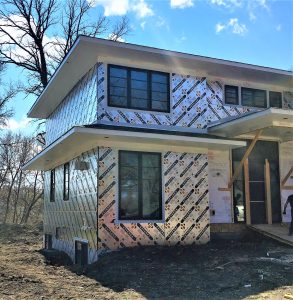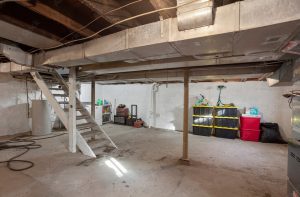Halo’s Interra Plus panels are more than just a “green choice”
Sustainable construction is no longer a trend. As more and more jurisdictions plan for a carbon-neutral future, building codes are evolving to reflect this new reality.
In this post, we’ll look at Halo’s Interra Plus – a low-carbon rigid insulation product that’s becoming the go-to choice for builders in the USA.
So, what is Halo’s Interra Plus?
Interra Plus is a new addition to Halo’s interior insulation series. Made with graphite-infused expanded polystyrene (GPS), these boards come with reflective laminate on both sides. The graphite boosts the R-value of the EPS, while the laminate acts as a vapor barrier. Unlike regular Interra, Interra Plus panels can be installed without drywall in the United States.
What sets “great” insulation apart from “OK” insulation? More R-value and less thickness.
GPS panels are basically EPS panels that pack graphite particles to absorb and reflect radiant heat. The graphite content boosts the R-value of the EPS by 18%+ without requiring a change in thickness. GPS R-values also match those of the top XPS products; however, unlike XPS products, GPS doesn’t deteriorate and therefore provides a more stable R-value over time.

Look no further to reduce your carbon footprint. We’re talking up to 20 times less carbon!
Halo’s Interra Plus has up to 20 times times less embodied carbon than two leading XPS contenders with similar performance. The difference in cost? Not a dime. Best of all, choosing a more sustainable GPS gives you a chance to upsell your homes.
Save money on the vapor barrier – Interra Plus already has one.
Due to the low permeability of its reflective laminate coating, these panels have a code-compliant vapor barrier built into their make-up. Taped and used with R-14 batt insulation, Interra Plus does not require a vapor barrier in any climate zone across Canada and the United States.
Are you in the United States? No drywall needed for select occupancies!
Most interior foam insulation needs a thermal barrier to shield it from fires and slow its temperature rise. Due to the way its GPS foam core is formulated, Interra Plus panels are exempt from this requirement in the majority of US jurisdictions. The exemption is valid for residential and commercial buildings if the Interra Plus panels are 2.28 inches thick or less.
Things to keep in mind
Going with Interra Plus to insulate your concrete or masonry foundation walls? Here are some helpful tips:
First, be sure to prep your walls. Be sure to remove any protrusions that could damage the panels, or prevent a flush alignment with the concrete. See to it that the wall is dry and free from dirt and debris. Place the panels directly against the wall.
Second, use the right adhesive. Secure the Interra Plus panels to the concrete with EPS-compatible, weather-resistant glue, such as PL300. Use concrete screws and washers along with the glue if the wall is too rough or uneven.
For detailed installation instructions, check out our Halo Interra Installation Guide.
Wrapping it up
Choosing products that cause fewer carbon emissions is a smart thing; especially if they perform better and cost less.
Halo’s Interra Plus hits the perfect balance between costs, value, and sustainability. By going with Interra Plus, you save on the cost of the vapor barrier (and drywall if you’re in the States). Your clients enjoy top energy efficiency and a reduced carbon footprint in their homes.









